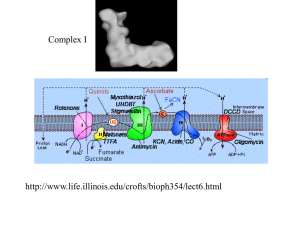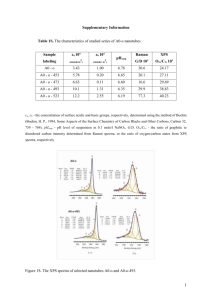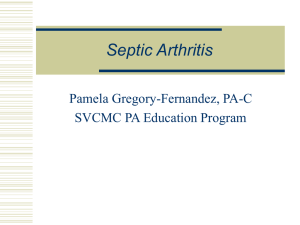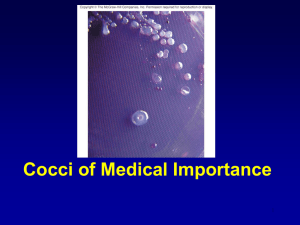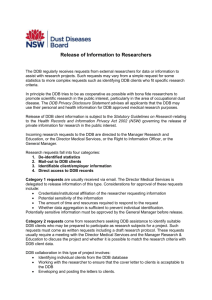mmi13120-sup-0001-si
advertisement
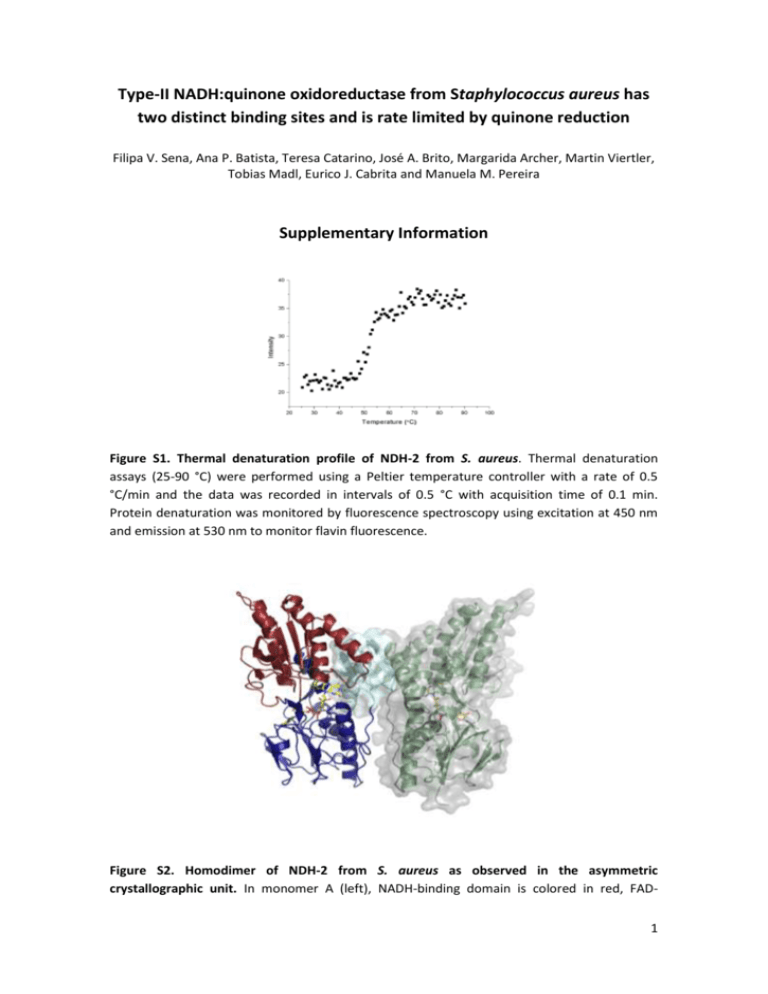
Type-II NADH:quinone oxidoreductase from Staphylococcus aureus has two distinct binding sites and is rate limited by quinone reduction Filipa V. Sena, Ana P. Batista, Teresa Catarino, José A. Brito, Margarida Archer, Martin Viertler, Tobias Madl, Eurico J. Cabrita and Manuela M. Pereira Supplementary Information Figure S1. Thermal denaturation profile of NDH-2 from S. aureus. Thermal denaturation assays (25-90 °C) were performed using a Peltier temperature controller with a rate of 0.5 °C/min and the data was recorded in intervals of 0.5 °C with acquisition time of 0.1 min. Protein denaturation was monitored by fluorescence spectroscopy using excitation at 450 nm and emission at 530 nm to monitor flavin fluorescence. Figure S2. Homodimer of NDH-2 from S. aureus as observed in the asymmetric crystallographic unit. In monomer A (left), NADH-binding domain is colored in red, FAD1 binding domain in blue and membrane attachment (C-terminal) domain in pale cyan with surface representation; FAD cofactor is shown in sticks with carbon atoms colored in yellow, oxygen in red and nitrogen in blue; in monomer B (right), cartoon representation is colored in green and solvent accessible area is represented as surface colored in grey. Figure S3. Size exclusion chromatography of NDH-2 from S. aureus. Superimposition of the chromatograms obtained for independent elutions of each standard protein (Blue Dextran, Ferritin, Aldolase, Conalbumin, BSA and Cytochrome c) and NDH-2. Blue dextran was used to determine the void volume. The elution volumes of the standards allowed obtaining a Ve/Vo vs log [MM] plot and calculating the molecular mass of NDH-2 in solution. 2 Figure S4. SAXS analyses. (A) Sequence alignment of S. cerevisiae (Uniprot-ID P32340), C. thermarum (Uniprot-ID F5L3B8), and S. aureus (Uniprot-ID Q2FZV7) NDH-2. The dimerization and C-terminal helices are labeled. Multiple sequence alignment was carried out using the CLUSTAL O (1.2.1) tool on the Uniprot webpage (http://www.uniprot.org); SAXS data of NDH2 from S. aureus were compared to SAXS data back-calculated from crystal structures of the homologous proteins from C. thermarum (4NWZ) and S. cerevisiae (4G9K) (Fig. 5). Clearly, neither of these two crystal structures was in good agreement with the data obtained for S. 3 aureus (Fig. 5). This result may reflect different possible orientations of the monomers, or an equilibrium between different conformations. In the crystal structures of the homologous proteins, the orientation of the NDH-2 monomers in the dimer is different. In NDH-2 from C. thermarum dimerization involves a long α-helix (Ser128-Ala147 in 4NWZ), whereas these residues are not in contact with each other in the structure of NDH-2 from S. cerevisiae, instead the dimer is stabilized by a network of contacts involving a C-terminal α-helix (Ala489Lys506 in 4G9K) and a loop region (Ser145-Ala165; (B) A shorter version of this C-terminal helix is conserved in NDHs-2 from S. aureus and C. thermarum (Leu393-Gly397 in 4NWZ), which may raise the hypothesis that NDH-2 from S. aureus, could establish a dimer interaction through this short helix, under certain conditions. In this case NDH-2 from S. aureus could adopt two different conformations in solution. Thus to test whether our results could be explained by a conformational equilibrium based on the two previous published structures, we estimated the ratio between the two different conformations, using the SAXS data back-calculated for the two homologous proteins. Provided that the scattering intensities of the end-point structures are known (form factors), SAXS data are a measure of the populations in the different conformations (in the form of volume fractions of each component). Indeed, a superposition of SAXS data back-calculated for the two homologous proteins and assuming a population ratio of 40:60 % (C. thermarum : S. cerevisiae) resulted in good agreement with the experimental data (C). In the twisted dimeric structure the membrane attachment region is located at the same side of the dimer. Both helices including the conserved hydrophobic residues (F388, I393, and F397) are oriented parallel to the membrane and well-available for membrane binding (D). Figure S5. Temperature profiles of the activity of NDH-2 from S. aureus. Temperature profiles of NADH:Quinone oxidoreductase activity (20-55 °C) using independently three different quinones, DMN, DDB and DQ. 4 Figure S6. Steady-state analyses of the activity of NDH-2 from S. aureus. NADH:Quinone oxidoreductase activity as function of the concentration of NADH (A), DMN (B), DDB (C) or Duroquinone (D). The data points were fitted with a Michaelis-Menten equation (full line), 𝑣0 = 𝑣𝑚𝑎𝑥 [𝑆] . 𝐾𝑚 +[𝑆] NADH:Quinone oxidoreductase activity as function of the concentration of NADH (A) could also be fitted with an equation that describes substrate inhibition, 𝑣0 = 𝑣𝑚𝑎𝑥 [𝑆] 𝐾𝑚 +[𝑆]+ [𝑆]2 𝐾𝐼 (dotted line). Figure S7. Steady-state analyses of the activity of NDH-2 from S. aureus in the presence of HQNO. NADH:Quinone oxidoreductase activity as function of the concentration of the inhibitor HQNO (2-n-Heptyl-4-hydroxyquinoline N-oxide, C16H21NO2) using as electron acceptor DMN. The data points were fitted using equation 𝑣0𝑖 = 𝑣0𝑚𝑎𝑥 [𝐼] ) 𝐾𝑖 𝑎𝑝𝑝 [𝐼] (1+ 𝑎𝑝𝑝 ) 𝐾𝑖 (1+𝛽 with Kiapp = 6.8 ± 0.4 µM. 5 Figure S8. Time-resolved oxidation of NADH reduced NDH-2 from S. aureus by DMN. The direction of the arrows shows the behavior of the absorbance upon oxidation by quinone, at 450 nm increased and the broad peak in the region 650-700 nm disappeared. Figure S9. Fast kinetics experiments. Time-resolved oxidation of NADH reduced NDH-2 by DDB (A) (1:1) or Duroquinone(B) (1:5). The absorbance at 450 nm increased and the broad peak in the region 650-700 nm disappeared. The observed rate constants of the two processes, acquired at 450 nm and at 670 nm, obtained by exponential fitting of the kinetic curves at 450 nm and 670 nm, were equal to 5 ± 2 s-1 for DDB and 2.2 ± 0.4 s-1 for Duroquinone. 6 Figure S10. Time-resolved reduction of NDH-2 from S. aureus at turnover. The decrease in the absorbance of the peak at 350 nm (red dots) corresponds to NADH consumption. The observed ∆Abs at 350 nm (~0.05) corresponds to the oxidation of 8 µM NADH, which is in agreement with the experiment set up (10 µM of NADH after mixing and 3 ms acquisition dead time). The noise at 350 nm is higher than at other wavelengths due to the smaller intensity of the lamp at this wavelength (equipment limit). Figure S11. Cartoon representation of the NDH-2 from S. aureus. The positions of the two tryptophan residues are highlighted. FAD cofactor is shown in sticks with carbons atoms colored in yellow, oxygen in red and nitrogen in blue. W261 is located at the re side of FAD while W49 is situated at the si side of FAD. 7 Figure S12. Fluorescence spectroscopy. The fluorescence emission spectrum of NDH-2 with excitation at 280 nm exhibited the characteristics of a typical tryptophan fluorescence spectrum, while the fluorescence emission spectrum with excitation at 450 nm was typical of a flavoprotein. Only slight changes were observed in the region of the flavin fluorescence emission spectra in the presence of some ligands. By contrast, the intensity in the region of the tryptophan fluorescence emission spectra changed significantly and differently upon addition of each ligand. Fluorescence emission spectra of NDH-2 with excitation at 280 nm, in the absence and in the presence of 100 µM DMN (A) or 100 µM NAD+ (B). Fluorescence emission spectra of NDH-2 with excitation at 450 nm, in the absence and in the presence of 100 µM DMN (C) or 100 µM NAD+(D). Change in the fluorescence emission at 330 nm with excitation at 280 nm of NDH-2 by sequential addition of DDB (E) or Duroquinone (F) or NADH (G). The solid lines were obtained by fitting the Monod-Wyman-Changeux (MWC) model equation, ∆𝐹 = ∆𝐹 𝑚𝑎𝑥 × [𝑆] [𝑆] (1+ ) 𝐾𝑠 𝐾𝑠 [𝑆] 2 𝐿+(1+ 𝐾𝑠 for a dimeric enzyme to the data using L=0. ) 8 Figure S13. STD-NMR Measurements. Reference spectrum (off resonance) and STD-NMR spectrum of NDH-2 from S. aureus in the presence of (A) DMN (B) DDB and (C) DQ. 9 Figure S14. STD-NMR spectra obtained in the presence of HQNO. (A) STD-NMR spectra of NDH-2 titrated with DMN in the presence of HQNO (▲, black closed triangle). (B) STD-NMR spectra of NDH-2 titrated with NAD+ in the presence of HQNO (■, black closed square). 10 Table S1. SAXS data and analysis. Sample Staphylococcus aureus NDH-2 + DMN + HQNO + DMN/HQNO + NAD + NADH Rg [Å] 34 ± 1 35 ± 1 38 ± 4 39 ± 4 36 ± 1 35 ± 1 Molecular mass [kDa]* 93 109 90 88 110 107 *The molecular mass was determined using Porod’s law. Table S2. Relative STD NMR values for the experiments of NDH-2 with DMN, DDB or DQ and for the STD competition experiments where the order of quinone addition was varied. Quinone DMN DDB DQ Peak number 1 2 3 1 2 1 Individual quinone 87% 99% 100% 87% 100% 100% DMN+DDB 85% 100% 98% 16% 16% - Relative STD* DDB+DMN 82% 100% 97% 16% 16% - DMN+DQ DQ+DMN 70% 100% 89% 27% 79% 94% 100% 34% * STD competition experiments were also performed with DQ and DDB but the peak overlaps between the peak 1 of DQ and the peak 1 of DDB not allowing determining individual relative STD responses. 11
